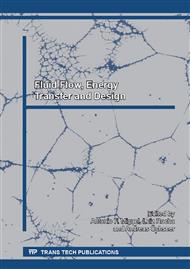[1]
S. Pindado, E. Vega, A. Martínez, E. Meseguer, S. Franchini, I. Sarasola, Analysis of calibration results from cup and propeller anemometers. Influence on wind turbine Annual Energy Production (AEP) calculations, Wind Energy 14 (2011) 119-132.
DOI: 10.1002/we.407
Google Scholar
[2]
S. Pindado, A. Barrero-Gil, A. Sanz, Cup anemometers' loss of performance due to ageing processes, and its effect on Annual Energy Production (AEP) estimates, Energies 5 (2012) 1664-1685.
DOI: 10.3390/en5051664
Google Scholar
[3]
S. Pindado, A. Sanz, A. Wery, Deviation of cup and propeller anemometer calibration results with air density, Energies 5 (2012) 683-701.
DOI: 10.3390/en5030683
Google Scholar
[4]
M. Sanuki, S. Kimura, H. Obana, The performance of half-covered cup-anemometers. Papers in Meteorology and Geophysics, Meteorological Research Institute of Japan 14 (1963) 52-57.
DOI: 10.2467/mripapers1950.14.1_52
Google Scholar
[5]
S. Ramachandran, A theoretical study of cup and vane anemometers, Q. J. R. Meteorol. Soc. 95 (1969) 163-180.
DOI: 10.1002/qj.49709540311
Google Scholar
[6]
J. Kondo, G. Naito, Y. Fujinawa, Response of cup anemometer in turbulence, J. Meteorol. Soc. Japan 49 (1971) 63-74.
Google Scholar
[7]
E.L. Deacon, The over-estimation error of cup anemometers in fluctuating winds, J. Sci. Instr. 28 (1951) 231-234.
DOI: 10.1088/0950-7671/28/8/303
Google Scholar
[8]
N.E. Busch, L. Kristensen, Cup anemometer overspeeding, J. Appl. Meteor. 15 (1976) 1328-1332.
DOI: 10.1175/1520-0450(1976)015<1328:cao>2.0.co;2
Google Scholar
[9]
J. C. Wyngaard, Cup, propeller, vane, and sonic anemometers in turbulence research, Annual Review of Fluid Mechanics 13 (1981) 399-423.
DOI: 10.1146/annurev.fl.13.010181.002151
Google Scholar
[10]
R.S. Hunter, The accuracy of cup anemometer calibration with particular regard to testing wind turbines, Wind Engineering 14 (1990) 32-43.
Google Scholar
[11]
S. Pindado, J. Pérez, S. Avila-Sanchez, On cup anemometer rotor aerodynamics, Sensors 12 (2012) 6198-6217.
DOI: 10.3390/s120506198
Google Scholar
[12]
L. Kristensen, Cup anemometer behavior in turbulent environments, Journal of Atmospheric and Oceanic Technology 15 (1998) 5-17.
DOI: 10.1175/1520-0426(1998)015<0005:cabite>2.0.co;2
Google Scholar
[13]
J. -Å. Dahlberg, T.F. Pedersen, P. Busche, ACCUWIND -Methods for Classification of Cup Anemometers, Risø–R–1555 (EN), Risø National Laboratory, Roskilde, Denmark, (2006).
Google Scholar
[14]
Measuring Network of Wind Energy Institutes (MEASNET), Anemometer Calibration Procedure, Version 2, (2009).
Google Scholar


